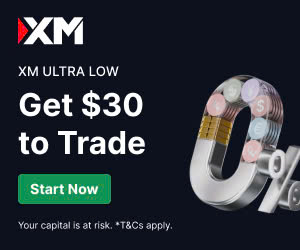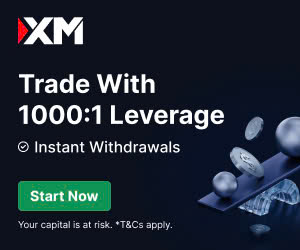
9 minute read
XM vs Vantage: A Comprehensive Comparison
Choosing the right forex broker is a critical decision for traders, whether you're a beginner or a seasoned professional. Two prominent names in the forex trading industry, XM vs Vantage, consistently stand out due to their robust platforms, competitive offerings, and strong regulatory frameworks. This comprehensive comparison of XM vs Vantage in 2025 will explore their features, fees, trading platforms, account types, regulation, and more to help you make an informed decision. By the end of this article, you’ll have a clear understanding of which broker aligns best with your trading goals.

💥 Trade with XM now: Open An Account or Visit Brokers 🏆
Overview of XM vs Vantage
XM: A Global Leader in Forex and CFD Trading
Founded in 2009, XM has grown into one of the most recognized forex brokers worldwide, serving over 3.5 million traders across 190 countries. Known for its user-friendly platforms and diverse range of trading instruments, XM caters to both novice and experienced traders. The broker is regulated by multiple authorities, including ASIC (Australia), CySEC (Cyprus), and IFSC (Belize), ensuring a high level of trust and security. XM is particularly praised for its low minimum deposits, extensive educational resources, and commission-free accounts.
Vantage: A Trusted Choice for Advanced Traders
Established in 2009, Vantage (previously Vantage FX) is another well-regarded broker, particularly favored by professional traders and scalpers. Vantage operates under strict regulations from FCA (UK), ASIC (Australia), VFSC (Vanuatu), and CIMA (Cayman Islands). The broker is known for its Raw ECN accounts, ultra-low spreads, and fast execution speeds, making it a go-to choice for high-frequency traders. Vantage also offers a wide range of trading instruments and advanced tools, appealing to those seeking a competitive edge.
Regulation and Trustworthiness
XM’s Regulatory Framework
XM operates under a robust regulatory framework, which enhances its credibility. It is licensed by:
· ASIC (Australia): Ensures adherence to strict financial standards.
· CySEC (Cyprus): Provides investor protection for EEA residents, including €20,000 compensation in case of broker insolvency.
· IFSC (Belize): Offers flexibility for global clients.
XM maintains segregated client accounts, negative balance protection, and comprehensive insurance, ensuring client funds are secure. With a Trust Score of 88/99, XM is considered low-risk and reliable.
Vantage’s Regulatory Oversight
Vantage is equally trustworthy, regulated by:
· FCA (UK): One of the most stringent regulators globally, ensuring transparency and client protection.
· ASIC (Australia): Upholds high standards of financial integrity.
· VFSC (Vanuatu) and CIMA (Cayman Islands): Provide additional regulatory oversight for global operations.
Vantage also offers segregated accounts and negative balance protection. Its Trust Score of 90/99 reflects its strong reputation in the forex trading community.
Verdict: Both brokers are highly regulated and trustworthy, with Vantage slightly edging out due to its FCA regulation, which is particularly appealing to UK traders. However, XM’s global reach and CySEC regulation make it a strong contender for European clients.
Trading Platforms
XM’s Trading Platforms
XM supports the industry-standard MetaTrader 4 (MT4) and MetaTrader 5 (MT5) platforms, available on desktop, web, and mobile devices. These platforms are known for:
· Advanced charting tools and technical indicators.
· Support for automated trading via Expert Advisors (EAs).
· One-click trading, trailing stops, and pending orders.
· Social trading features for copying successful traders.
XM also offers a web-based platform and a mobile app, ensuring flexibility for traders on the go. However, its platform offerings are limited to MT4 and MT5, which may feel restrictive for traders seeking proprietary or alternative platforms.
Vantage’s Trading Platforms
Vantage provides a broader range of platforms, including:
· MetaTrader 4 and MetaTrader 5: Similar to XM, with full support for EAs, advanced charting, and one-click trading.
· WebTrader: A browser-based platform for quick access without downloads.
· CHARTS by TradingView: A powerful charting tool favored by advanced traders for its customizable interface and in-depth analysis.
· Vantage Mobile App: Offers smooth execution and market access on iOS and Android devices.
Vantage’s inclusion of TradingView charts gives it an edge for traders who prioritize advanced technical analysis.
Verdict: Vantage offers more platform variety with TradingView integration, making it ideal for traders who value advanced charting. XM’s MT4/MT5 focus is reliable but less diverse.
Account Types
XM Account Types
XM offers four main account types tailored to different trading needs:
· Micro Account: Ideal for beginners, with a $5 minimum deposit and micro-lot trading.
· Standard Account: Suited for most traders, with a $5 minimum deposit and standard lot sizes.
· XM Zero Account: Designed for scalpers, with spreads as low as 0.0 pips and a $3.50 commission per lot per side.
· Shares Account: For trading real stocks, available under the IFSC-regulated entity.
XM also provides Islamic (swap-free) accounts and a demo account for practice. The low minimum deposit makes XM accessible to beginners, while the Zero Account appeals to high-frequency traders.
Vantage Account Types
Vantage offers three primary account types:
· Standard STP Account: No commissions, with spreads starting at 1.3 pips, suitable for beginners.
· Raw ECN Account: Ultra-low spreads from 0.0 pips with a $6 round-turn commission, ideal for scalpers.
· Pro ECN Account: Designed for professional traders, with lower commissions and premium features.
Vantage also supports Islamic accounts, demo accounts, and STP accounts for direct market access. The Raw ECN account is particularly attractive for traders prioritizing low trading costs.
Verdict: XM’s low minimum deposit and diverse account types make it more beginner-friendly. Vantage’s ECN accounts are better suited for experienced traders seeking tighter spreads and faster execution.
Fees and Spreads
XM Fees and Spreads
XM’s fee structure varies by account type:
· Micro and Standard Accounts: Commission-free, with spreads starting at 0.6 pips (EUR/USD average: 1.6–1.8 pips).
· XM Zero Account: Spreads from 0.0 pips, with a $3.50 commission per lot per side.
· Inactivity Fee: $5/month after 90 days of inactivity.
· Withdrawal Fees: No fees for most methods, but bank withdrawals below $200 incur a $15 fee.
XM’s stock index CFD fees are low, but forex and stock CFD fees are average compared to competitors.
Vantage Fees and Spreads
Vantage is known for competitive pricing:
· Standard STP Account: No commissions, with spreads averaging 1.3 pips on EUR/USD.
· Raw ECN Account: Spreads from 0.0 pips, with a $6 round-turn commission.
· Pro ECN Account: Similar to Raw ECN but with lower commissions for high-volume traders.
· No Inactivity or Withdrawal Fees: Vantage covers transaction fees, enhancing cost efficiency.
Vantage’s Raw ECN account offers tighter spreads than XM’s Zero Account, making it more cost-effective for active traders.
Verdict: Vantage generally offers lower trading costs, especially for ECN accounts, while XM’s commission-free accounts are better for casual traders. However, XM’s inactivity fee is a drawback.
Trading Instruments
XM’s Trading Instruments
XM offers over 1,000 instruments, including:
· Forex (currency pairs).
· CFDs on stocks, commodities, indices, and cryptocurrencies.
· Precious metals (gold, silver).
· Energies (oil).
While XM’s forex and CFD offerings are extensive, real stocks are only available under its IFSC-regulated entity, and cryptocurrency trading is limited to specific regions.
Vantage’s Trading Instruments
Vantage provides a slightly broader range, including:
· Forex (currency pairs).
· CFDs on indices, commodities, and ETFs.
· Bonds and energies (oil).
· Precious metals and soft commodities.
Vantage’s inclusion of bonds and ETFs gives it an edge for traders seeking diversification.
Verdict: Vantage offers more diverse trading instruments, particularly with bonds and ETFs, while XM’s extensive forex and CFD options are sufficient for most traders.

💥 Trade with XM now: Open An Account or Visit Brokers 🏆
Educational Resources and Market Analysis
XM’s Educational Resources
XM excels in education, offering:
· Webinars and video tutorials covering forex basics, strategies, and risk management.
· Daily market reviews and technical analysis videos.
· A comprehensive economic calendar and trading signals.
· A demo account for practice.
These resources make XM an excellent choice for beginners looking to build their trading knowledge.
Vantage’s Educational Resources
Vantage also provides robust educational tools:
· E-books, video tutorials, and webinars on forex concepts and strategies.
· Daily market news and technical analysis articles.
· An economic calendar and advanced market analysis tools.
· Monthly client webinars and a searchable archive of past sessions.
Vantage’s advanced trading videos and TradingView integration enhance its appeal for experienced traders.
Verdict: Both brokers offer strong educational resources, but XM is slightly better for beginners due to its extensive webinars and trading signals. Vantage caters more to advanced traders with its in-depth analysis tools.
Customer Support
XM Customer Support
XM provides 24/5 customer support via:
· Live chat, email, and phone.
· Multilingual support in over 25 languages.
· Fast response times and friendly service.
However, support is unavailable on weekends, which may inconvenience some traders.
Vantage Customer Support
Vantage also offers 24/5 support through:
· Live chat, email, and phone.
· Multilingual assistance for global clients.
· A reputation for quick and professional responses.
Vantage’s support quality is comparable to XM’s, with no significant differences in accessibility.
Verdict: Both brokers provide reliable customer support, with no clear winner. The 24/5 availability may be a limitation for traders in certain time zones.
Pros and Cons
XM Pros
· Low minimum deposit ($5) for Micro and Standard accounts.
· Commission-free accounts for casual traders.
· Extensive educational resources and trading signals.
· Strong global presence and regulation.
· Islamic accounts available.
XM Cons
· Inactivity fees after 90 days.
· Limited platform variety (only MT4/MT5).
· Average forex and stock CFD fees.
· High leverage (1:888) unavailable in some regions.
Vantage Pros
· Ultra-low spreads on Raw ECN accounts.
· No inactivity or withdrawal fees.
· Diverse platforms, including TradingView integration.
· FCA regulation for UK traders.
· Fast execution speeds for scalpers.
Vantage Cons
· Higher minimum deposit for ECN accounts.
· Fixed spreads may not suit all trading styles.
· Less beginner-focused than XM.
Which Broker Should You Choose?
The choice between XM vs Vantage depends on your trading experience, goals, and preferences:
· Choose XM if:
· You’re a beginner or casual trader looking for low minimum deposits and commission-free accounts.
· You value extensive educational resources and trading signals.
· You prefer a globally recognized broker with a strong presence in multiple regions.
· Choose Vantage if:
· You’re an experienced trader or scalper seeking ultra-low spreads and fast execution.
· You want access to advanced platforms like TradingView and diverse trading instruments.
· You prioritize FCA regulation and no inactivity fees.
Conclusion
Both XM vs Vantage are reputable forex brokers with unique strengths in 2025. XM shines for its accessibility, beginner-friendly features, and global reach, making it an excellent choice for new traders or those seeking a reliable all-around platform. Vantage, on the other hand, stands out for its competitive pricing, advanced tools, and appeal to professional traders, particularly scalpers and high-frequency traders.
Ultimately, the best broker depends on your trading style and priorities. For beginners, XM’s low entry barriers and educational resources are hard to beat. For advanced traders, Vantage’s ECN accounts and platform variety offer a competitive edge. Evaluate your needs, test their demo accounts, and choose the broker that aligns with your trading journey.
💥 Note: To enjoy the benefits of the partner code, such as trading fee rebates, you need to register with XM through this link: Open An Account or Visit Brokers 🏆
Read more:




